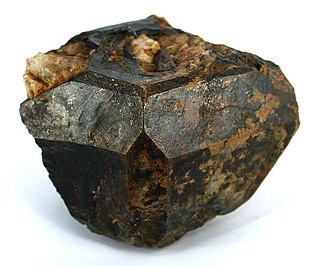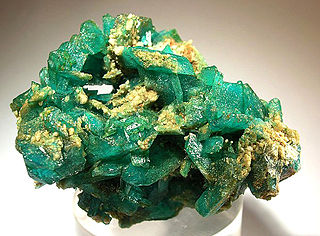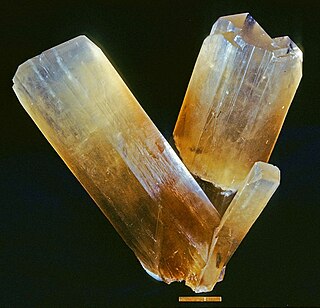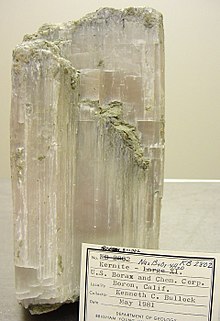
Ulexite (NaCaB5O6(OH)6·5H2O, hydrated sodium calcium borate hydroxide), sometimes known as TV rock or Television stone, is a mineral occurring in silky white rounded crystalline masses or in parallel fibers. The natural fibers of ulexite conduct light along their long axes, by internal reflection. Ulexite was named for the German chemist Georg Ludwig Ulex (1811–1883) who first discovered it.

Colemanite (Ca2B6O11·5H2O) or (CaB3O4(OH)3·H2O) is a borate mineral found in evaporite deposits of alkaline lacustrine environments. Colemanite is a secondary mineral that forms by alteration of borax and ulexite.

Vivianite (Fe2+
Fe2+
2(PO
4)
2·8H
2O) is a hydrated iron phosphate mineral found in a number of geological environments. Small amounts of manganese Mn2+, magnesium Mg and calcium Ca may substitute for iron Fe2+ in the structure. Pure vivianite is colorless, but the mineral oxidizes very easily, changing the color, and it is usually found as deep blue to deep bluish green prismatic to flattened crystals.
Vivianite crystals are often found inside fossil shells, such as those of bivalves and gastropods, or attached to fossil bone.

Erythrite or red cobalt is a secondary hydrated cobalt arsenate mineral with the formula Co
3(AsO
4)
2•8H
2O. Erythrite and annabergite, chemical formula Ni
3(AsO
4)
2•8H
2O, or nickel arsenate form a complete series with the general formula (Co,Ni)
3(AsO
4)
2•8H
2O.

Trona (trisodium hydrogendicarbonate dihydrate, also sodium sesquicarbonate dihydrate, Na2CO3•2NaHCO3•3H2O) is a non-marine evaporite mineral. It is mined as the primary source of sodium carbonate in the United States, where it has replaced the Solvay process used in most of the rest of the world for sodium carbonate production.

Thénardite is an anhydrous sodium sulfate mineral, Na2SO4 which occurs in arid evaporite environments, specifically lakes and playas. It also occurs in dry caves and old mine workings as an efflorescence and as a crusty sublimate deposit around fumaroles. It occurs in volcanic caves on Mount Etna, Italy. It was first described in 1825 for an occurrence in the Espartinas Saltworks, Ciempozuelos, Madrid, Spain and was named for the French chemist, Louis Jacques Thénard (1777–1826).

Abernathyite is a mineral with formula K(UO2)(AsO4)·3H2O. The mineral is named after Jesse Evrett Abernathy (1913–1963) who first noted it in 1953 in the U.S. State of Utah. It was described as a new mineral species in 1956. Abernathyite is yellow and occurs as small crystals.

Kermesite or antimony oxysulfide is also known as red antimony (Sb2S2O). The mineral's color ranges from cherry red to a dark red to a black. Kermesite is the result of partial oxidation between stibnite (Sb2S3) and other antimony oxides such as valentinite (Sb2O3) or stibiconite (Sb3O6(OH)). Under certain conditions with oxygenated fluids the transformation of all sulfur to oxygen would occur but kermesite occurs when that transformation is halted.

Ajoite is a hydrated sodium potassium copper aluminium silicate hydroxide mineral. Ajoite has the chemical formula (Na,K)Cu7AlSi9O24(OH)6·3H2O, and minor Mn, Fe and Ca are usually also present in the structure. Ajoite is used as a minor ore of copper.

Tincalconite is a hydrous sodium borate mineral closely related to borax, and is a secondary mineral that forms as a dehydration product of borax. Its formula is Na2B4O7·5H2O or Na2[B4O5(OH)4]·3H2O.

Microlite was once known as a pale-yellow, reddish-brown, or black isometric mineral composed of sodium calcium tantalum oxide with a small amount of fluorine. Its chemical formula is(Na,Ca)2Ta2O6(O,OH,F). Today it is a name of a group of oxide minerals of a similar stoichiometry having tantalum prevailing over titanium and niobium. The microlite group belongs to a large pyrochlore supergroup that occurs in pegmatites and constitutes an ore of tantalum. It has a Mohs hardness of 5.5 and a variable specific gravity of 4.2 to 6.4. It occurs as disseminated microscopic subtranslucent to opaque octahedral crystals with a refractive index of 2.0 to 2.2. Microlite is also called djalmaite, but both names are now obsolete.

Kröhnkite ( Na2Cu(SO4)2•2H2O ) is a rare copper sulfate mineral named after B. Kröhnke who first researched it. Kröhnkite may be replaced by Saranchinaite, the anhydrous form of the mineral, if heated to temperatures above 200 °C (392 °F).

Shigaite is a mineral with formula NaAl3(Mn2+)6(SO4)2(OH)18·12H2O that typically occurs as small, hexagonal crystals or thin coatings. It is named for Shiga Prefecture, Japan, where it was discovered in 1985. The formula was significantly revised in 1996, identifying sodium as a previously unknown constituent.

Huemulite is a mineral with formula Na4Mg(V10O28)·24H2O that is yellow to orange in color. It was first discovered in Argentina in 1959 and described in 1966. The mineral is named for the Huemul mine in which it was discovered.

Bicchulite has an ideal chemical formula of 2CaO •Al2O3 •SiO2 •H2O, which was formularized from the hydrothermal synthesis of synthetic gehlenite (2CaO •Al2O3 •SiO2). Also, bicchulite was sighted in the mines of Japan with related minerals. This sodalite-type structured bicchulite has an uncommon ratio of aluminium to silicon, causing difficulties deciphering the structure. Because of bicchulite's structure it has a powdery texture, which leads to complications in obtaining information on the mineral's physical properties. Despite this problem, the color, specific gravity, and crystal size of bicchulite are known. Although bicchulite was only discovered about 40 years ago, technology has been rapidly advancing, allowing more accurate results to be made from experiments done today.

Guyanaite (CrOOH) is a chromium oxide mineral that forms as an intergrowth with other chromium oxide minerals known as bracewellite (CrOOH) and grimaldiite (CrOOH) as well as eskolaite (Cr2O3) which in early findings were nearly indistinguishable from one another. These oxides formed so closely as intergrowths with one another that they were initially, and erroneously, identified as a single definite mineral previously known as merumite. Because of its complex history and the previously undiscovered nature of these chromium oxide polymorphs, the relevance of any information found in many early experiments involving the mineral formerly known as merumite in regard to guyanaite is unknown and it is implied that in any further reference of merumite it will have been composed of a mineral assemblage including guyanaite. The rare occurrence and complexity from intergrowth of naturally occurring guyanaite hinders experimental work, leading to laboratory synthesized samples which help to better experiment with the minerals.

Pinnoite is a magnesium borate mineral with formula: MgB2O(OH)6 or MgB2O4·3(H2O). It crystallizes in the tetragonal crystal system and occurs as colorless to yellow or light green radial fibrous clusters and rarely as short prismatic crystals.

Köttigite is a rare hydrated zinc arsenate which was discovered in 1849 and named by James Dwight Dana in 1850 in honour of Otto Friedrich Köttig (1824–1892), a German chemist from Schneeberg, Saxony, who made the first chemical analysis of the mineral. It has the formula Zn3(AsO4)2·8H2O and it is a dimorph of metaköttigite, which means that the two minerals have the same formula, but a different structure: köttigite is monoclinic and metaköttigite is triclinic. There are several minerals with similar formulae but with other cations in place of the zinc. Iron forms parasymplesite Fe2+3(AsO4)2·8H2O; cobalt forms the distinctively coloured pinkish purple mineral erythrite Co3(AsO4)2·8H2O and nickel forms annabergite Ni3(AsO4)2·8H2O. Köttigite forms series with all three of these minerals and they are all members of the vivianite group.
Lahnsteinite is a basic sulfate mineral first discovered in the Friedrichssegen Mine, Germany in a goethite cavity. Though found in goethite, the crystals of Lahnsteinite are few millimeters in size, and are tabular shaped. Lahnsteinite was the first mineral discovered in the Lahn Valley deposits. The empirical formula for lahnsteinite is (Zn3.3,Fe0.27,Cu0.11)3.91(S0.98O4)(OH)5*3H2.10O.

Borax is a borate mineral found in evaporite deposits of alkaline lacustrine environments and as a surface efflorescence in arid regions. It is the chief mineral mined from the deposits at Boron, California and nearby locations, and is the chief source of commercial borax.



















